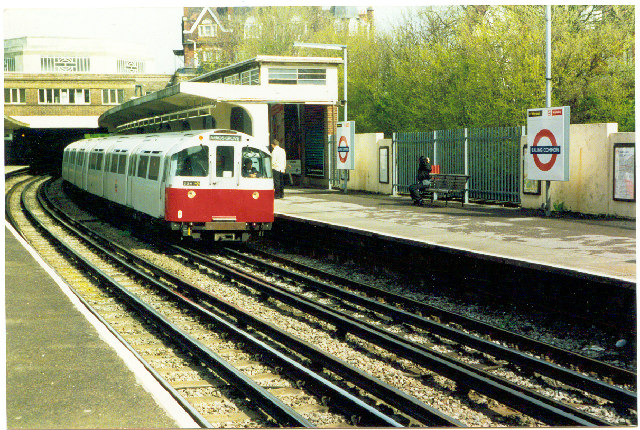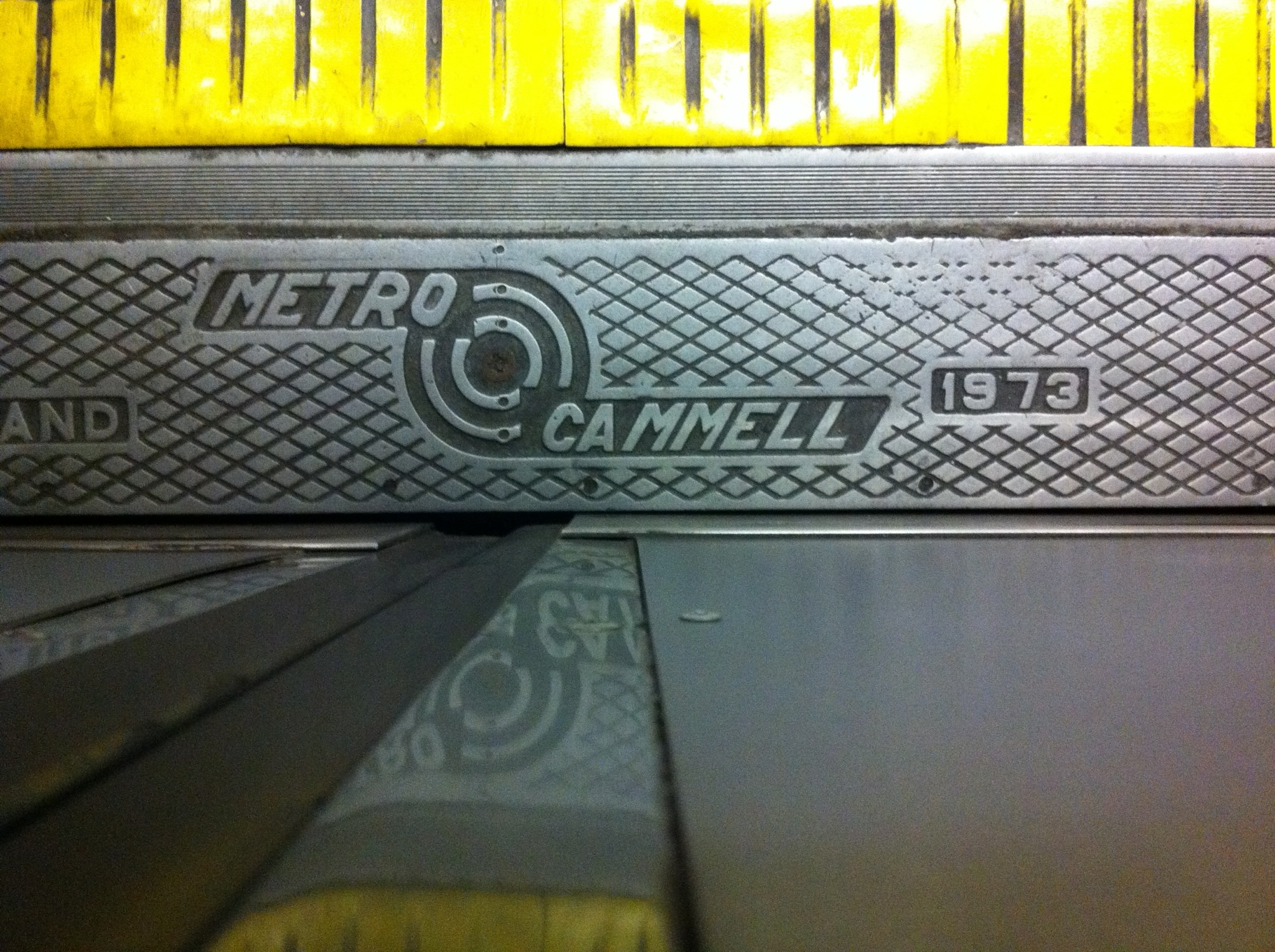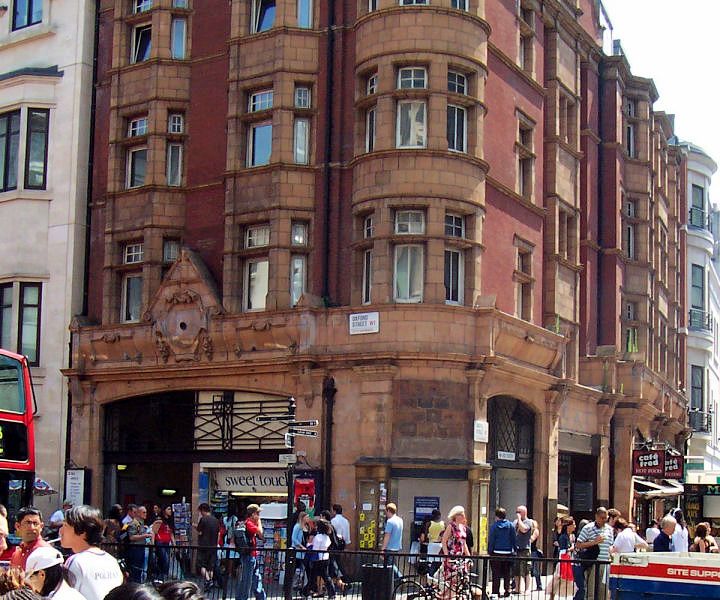|
London Underground 1973 Stock
The London Underground 1973 Stock is a type of rolling stock used on the Piccadilly line of the London Underground. It was introduced into service in 1975 with the extension of the line to Hatton Cross, followed by a further extension to Heathrow Central in 1977. A total of 86 six-car trains were built. The trains were built by Metro-Cammell between 1974 and 1977, and were refurbished by Bombardier Transportation between 1996 and 2001. They are some of the oldest trains running on the Underground, and in Britain as a whole, second only to the 1972 Stock running on the Bakerloo line. History In the early 1970s London Transport placed an order for a new fleet of trains to replace the 1938 Stock and 1959 Stock vehicles which previously operated on the Piccadilly line. Built between 1974 and 1977 by Metro Cammell in Birmingham, the first unit entered service on 19 July 1975 and the last was introduced by 1977. The trains featured longer cars and larger door space than the p ... [...More Info...] [...Related Items...] OR: [Wikipedia] [Google] [Baidu] |
Metro-Cammell
Metro-Cammell, formally the Metropolitan Cammell Carriage and Wagon Company (MCCW), was an English manufacturer of railway carriages, locomotives and railway wagons, based in Saltley, and subsequently Washwood Heath, in Birmingham. Purchased by GEC Alsthom in May 1989, the Washwood Heath factory was closed in 2005. The company designed and built trains for the railways in the United Kingdom and overseas, including the Mass Transit Railway of Hong Kong, Kowloon–Canton Railway (now East Rail line), the Channel Tunnel, and the Tyne and Wear Metro, and locomotives for Malaysia's Keretapi Tanah Melayu. Diesel and electric locomotives were manufactured for South African Railways, Nyasaland Railways, Malawi, Nigeria, Trans-Zambezi Railway and Pakistan. DMUs were supplied to Jamaica Railway Corporation and the National Railways of Mexico. The vast majority of London Underground rolling stock manufactured in mid-20th century was produced by the company. It also designed and built ... [...More Info...] [...Related Items...] OR: [Wikipedia] [Google] [Baidu] |
Bakerloo Line
The Bakerloo line () is a London Underground line that goes from in suburban north-west London to in south London, via the West End. Printed in brown on the Tube map, it serves 25 stations, 15 of which are underground, over . It runs partly on the surface and partly in deep-level tube tunnels. The line's name is a portmanteau of its original name, the Baker Street & Waterloo Railway. From to Harrow & Wealdstone (the section above ground), the line shares tracks with the London Overground Watford DC line and runs parallel to the West Coast Main Line. There is, however, a short tunnel at the western end of . Opened between 1906 and 1915, many of its stations retain elements of their design to a common standard: the stations below ground using Art Nouveau decorative tiling by Leslie Green, and the above-ground stations built in red brick with stone detailing in an Arts & Crafts style. It is the ninth-busiest line on the network, carrying more than 111 million passengers annu ... [...More Info...] [...Related Items...] OR: [Wikipedia] [Google] [Baidu] |
ASLEF
The Associated Society of Locomotive Engineers and Firemen (ASLEF) is a British trade union representing train drivers. It is part of the International Transport Workers' Federation and the European Transport Workers' Federation. At the end of 2018 ASLEF had 22,424 members. Its current General Secretary is Mick Whelan. History Foundation In 1865, North Eastern Railway footplatemen founded a union called the Engine Drivers' and Firemen's Society.Raynes, 1921, p. 22. It unsuccessfully attempted strike action, as a result of which the NER was able to break up the Society. In 1872, an industrial union, the Amalgamated Society of Railway Servants, was founded with the support of the Liberal MP Michael Bass. In 1872, the ASRS reported having 17,247 members, but by 1882, this had declined to only 6,321. By the end of the 1870s, many UK railway companies had increased the working week from 60 to 66 hours, a 12-hour working day was common and wages had been reduced.Raynes, 1921, ... [...More Info...] [...Related Items...] OR: [Wikipedia] [Google] [Baidu] |
New Tube For London
The New Tube for London (NTfL) is a type of London Underground train to be built by Siemens as part of its Inspiro family at Siemens's factories in Goole (East Yorkshire) and Vienna, Austria. An initial batch of 94 nine-car trains has been ordered at a cost of £1.5billion to replace 1973 Stock trains on the Piccadilly line, with options for a total of 250 trains allowing replacement of all existing trains on the deep-level Central, Waterloo & City and Bakerloo lines. Planned starting date for the service is 2025, firstly on the Piccadilly line, with a train driver, but equipped for driverless operation. History Background In the late 1990s, the Labour government initiated a public–private partnership (PPP) to reverse years of underinvestment in London Underground. Under the PPP contracts, two private consortiums (Metronet and Tube Lines) would maintain, renew and upgrade London Underground infrastructure over a period of 30 years from 2003. As part of the upgrade wo ... [...More Info...] [...Related Items...] OR: [Wikipedia] [Google] [Baidu] |
Waterloo & City Line
The Waterloo & City line, colloquially known as The Drain, is a London Underground shuttle line that runs between Waterloo and Bank with no intermediate stops. Its primary traffic consists of commuters from south-west London, Surrey and Hampshire arriving at Waterloo main line station and travelling forward to the City of London financial district. For this reason, the line has historically not operated on Sundays or public holidays, except in very limited circumstances. However, following the COVID-19 pandemic, the line is currently only open on weekdays. It is one of only two lines on the Underground network to run completely underground, the other being the Victoria line. Printed in turquoise on the Tube map, it is by far the shortest line on the Underground network, being long, with an end-to-end journey lasting just four minutes. In absolute terms, it is the least-used Tube line, carrying just over 15 million passengers annually. However, in terms of the average nu ... [...More Info...] [...Related Items...] OR: [Wikipedia] [Google] [Baidu] |
Modern Railways
''Modern Railways'' is a British monthly magazine covering the rail transport industry which was published by Ian Allan until March 2012, and Key Publishing since then. It has been published since 1962. The magazine was originally based in Shepperton, Middlesex. It has always been targeted at both railway professionals and serious amateurs, an aim which derives from its origins as an amalgamation of the enthusiast magazine ''Trains Illustrated'' and the industry journal ''The Locomotive'' in the hands of its first editor Geoffrey Freeman Allen. It is currently edited by Philip Sherratt after the retirement of James Abbott. Regular contributors include Roger Ford, Ian Walmsley, Alan Williams and Tony Miles. The large section regularly written by Roger Ford is called ‘Informed Sources’. That by Ian Walmsley is called ‘Pan Up’. Trains Illustrated The first edition of ''Trains Illustrated'' was published at the beginning of 1946. Due to post-war paper shortages issues 1 ... [...More Info...] [...Related Items...] OR: [Wikipedia] [Google] [Baidu] |
Central Line (London Underground)
The Central line is a London Underground line that runs through central London, from , Essex, in the north-east to and in west London. Printed in red on the Tube map, the line serves 49 stations over . It is one of only two lines on the Underground network to cross the Greater London boundary, the other being the Metropolitan line. One of London's deep-level railways, Central line trains are smaller than those on British main lines. The line was opened as the Central London Railway in 1900, crossing central London on an east–west axis along the central shopping street of Oxford Street to the financial centre of the City of London. It was later extended to the western suburb of Ealing. In the 1930s, plans were created to expand the route into the new suburbs, taking over steam-hauled outer-suburban routes to the borders of London and beyond to the east. These projects were mostly realised after Second World War, when construction stopped and the unused tunnels were used as air ... [...More Info...] [...Related Items...] OR: [Wikipedia] [Google] [Baidu] |
Northern Line
The Northern line is a London Underground line that runs from North London to South London. It is printed in black on the Tube map. The Northern line is unique on the Underground network in having two different routes through central London, two southern branches and two northern branches. Despite its name, it does not serve the northernmost stations on the Underground, though it does serve the southernmost station at , the terminus of one of the two southern branches. The line's northern termini, all in the London Borough of Barnet, are at and ; is the terminus of a single-station branch line off the High Barnet branch. The two main northern branches run south to join at where two routes, one via in the West End and the other via in the City, continue to join at in Southwark. At Kennington, the line again divides into two branches, one to each of the southern termini at , in the borough of Merton, and in Wandsworth. For most of its length it is a deep tube line. The por ... [...More Info...] [...Related Items...] OR: [Wikipedia] [Google] [Baidu] |
Bakerloo
The Bakerloo line () is a London Underground line that goes from in suburban north-west London to in south London, via the West End of London, West End. Printed in brown on the Tube map, it serves 25 stations, 15 of which are underground, over . It runs partly on the surface and partly in deep-level tube tunnels. The line's name is a portmanteau of its original name, the Baker Street & Waterloo Railway. From to Harrow & Wealdstone station, Harrow & Wealdstone (the section above ground), the line shares tracks with the London Overground Watford DC line and runs parallel to the West Coast Main Line. There is, however, a short tunnel at the western end of . Opened between 1906 and 1915, many of its stations retain elements of their design to a common standard: the stations below ground using Art Nouveau decorative tiling by Leslie Green, and the above-ground stations built in red brick with stone detailing in an Arts and Crafts movement, Arts & Crafts style. It is the ninth-bus ... [...More Info...] [...Related Items...] OR: [Wikipedia] [Google] [Baidu] |
London Transport (brand)
London Transport (LT) was the public name and brand used by a series of public transport authorities in London, England, from 1933. Its most recognizable feature was the bar-and-circle 'roundel' logo. With its origins in the Underground Electric Railways Company of London (UERL), the brand was first used by the London Passenger Transport Board (LPTB) to unify the identity of the previously separately owned and managed London Underground, Metropolitan Railway, bus and tram services. The London Transport brand was extended under the direction of Frank Pick to all aspects of transport operation including poster designs, tickets, train livery, seat upholstery and the station architecture of Charles Holden. When public transport operation was taken over by Transport for London (TFL) from London Regional Transport (LRT) in 2000, the London Transport brand was discontinued and replaced with Transport for London's own branding, which incorporates many features of the London Transport bran ... [...More Info...] [...Related Items...] OR: [Wikipedia] [Google] [Baidu] |
Horbury Railway Works
Horbury, near Wakefield, West Yorkshire, England was the site of two wagon works constructed during the Victorian period of industrialisation. Charles Roberts & Company's wagon works was located at Horbury Junction southeast of Horbury, West Yorkshire, England. It became part of the Procor group in the 1970s as Procor Engineering Ltd. and, subsequently, part of Bombardier Inc.'s European railway businesses in 1990 as Bombardier Prorail (Horbury), closing in 2005. The Yorkshire Railway Wagon Company was based near Horbury Bridge west of Horbury. Yorkshire Railway Wagon Co. The Yorkshire Railway Wagon Company was incorporated in 1862, by 1869 it had produced over 2000 wagons. The factory was located to the west of Horbury railway station to the north of the Manchester and Leeds Railway line. The factory closed in the second half of the twentieth century and the site is used as ''Quarry Hill Industrial Estate''. Charles Roberts & Co. Charles Roberts & Co. Ltd. was esta ... [...More Info...] [...Related Items...] OR: [Wikipedia] [Google] [Baidu] |
7 July 2005 London Bombings
The 7 July 2005 London bombings, often referred to as 7/7, were a series of four coordinated suicide attacks carried out by Islamic terrorists in London that targeted commuters travelling on the city's public transport system during the morning rush hour. Three terrorists separately detonated three homemade bombs in quick succession aboard London Underground trains across the city and, later, a fourth terrorist detonated another bomb on a double-decker bus in Tavistock Square. The train bombings occurred on the Circle line near and at Edgware Road, and on the Piccadilly line near . Apart from the bombers, 52 UK residents of 18 different nationalities were killed and more than 700 were injured in the attacks, making it the UK's deadliest terrorist incident since the 1988 bombing of Pan Am Flight 103 near Lockerbie, as well as the country's first Islamist suicide attack. The explosions were caused by improvised explosive devices made from triacetone triperoxide, pack ... [...More Info...] [...Related Items...] OR: [Wikipedia] [Google] [Baidu] |


.jpg)
.jpg)



.jpg)
